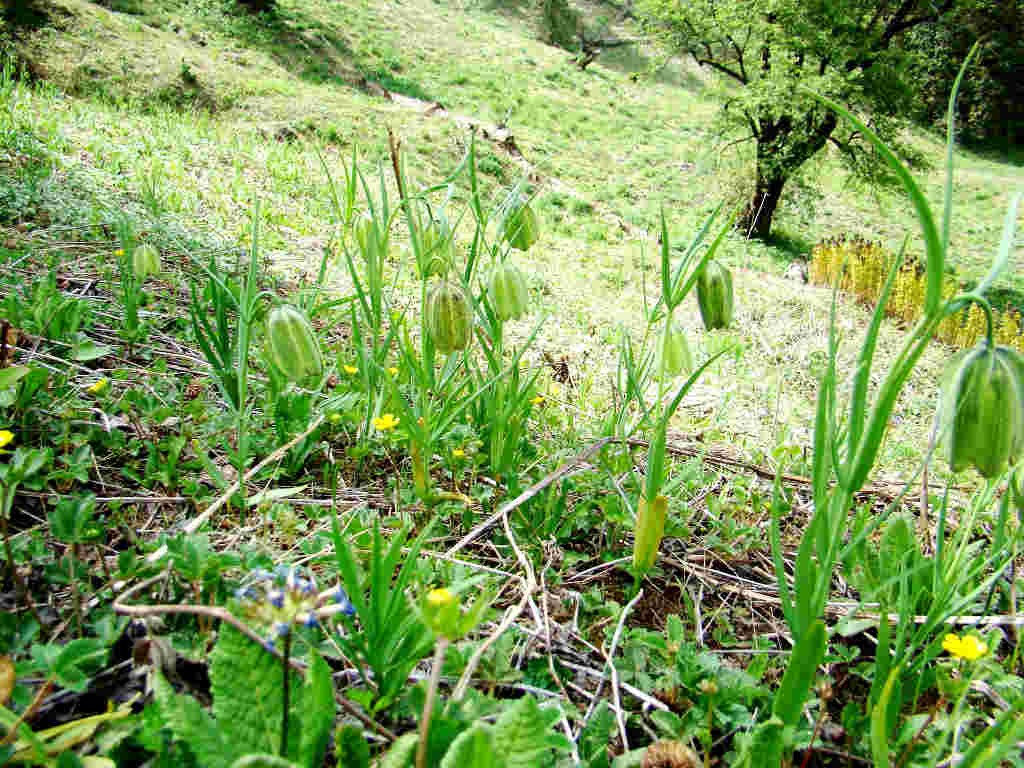
Fritillaria roylei (Van lahusan)
Fritillaria roylei, commonly known as Van Lahusan, is a striking species of flowering plant native to the Himalayan region, particularly found in areas like Himachal Pradesh, Jammu & Kashmir, and the Great Himalayan National Park (GHNP). Known for its ornamental beauty and medicinal properties, it is a valuable plant in both botanical research and traditional medicine.
Natural Habitat and Occurrence in GHNP
Fritillaria roylei is primarily found in the temperate and subalpine regions of the Himalayas. It thrives at elevations between 2,000 and 3,500 meters, often in alpine meadows, rocky slopes, and forested areas. In the Great Himalayan National Park, it flourishes in the well-drained soils and moderate sunlight of these rugged terrains, playing a vital role in the mountain ecosystems.
Botanical Description
Fritillaria roylei is a bulbous perennial that produces bell-shaped flowers in shades of yellow to greenish-yellow. These flowers bloom in clusters during the spring months, adding a beautiful contrast to the alpine meadows. The plant typically reaches heights of 30 to 40 cm, and its narrow leaves grow in a whorled pattern around the stem. It is easily recognizable by its unique flower structure, which often resembles a small bell or lantern, making it a distinctive addition to the diverse flora of the Himalayas.
Medicinal Uses
Fritillaria roylei has been used for centuries in traditional medicine for its therapeutic properties. The plant is known for its anti-inflammatory, antioxidant, and analgesic effects, making it highly valuable in the treatment of various ailments. Common uses include:
-
Treatment of respiratory conditions, such as asthma and cough
-
Pain relief and anti-inflammatory treatment for joint and muscle pain
-
Promoting digestive health and alleviating stomach-related issues
-
Used as a diuretic and to reduce fluid retention
Despite its medicinal benefits, it is recommended to use this plant under the guidance of a qualified herbalist or healthcare provider due to its strong bioactive compounds.
| Local name | Himalayan Fritillary (Van lahusan) |
| Botanical name | Fritillaria roylei |
| Family | Liliaceae (Lily family) |
| Description and uses | Himalayan Fritillary is a herbacious plant, 0.5-2 ft tall, commonly found in alpine slopes and shrubberies of the Himalayas, from Pakistan to Uttarakhand, at altitudes of 2700-4000 m. Flowers are yellowish-green to brownish-purple and usually with a chequered pattern in dull purple. Flowers are broadly bell-shaped, hanging looking down, borne singly on the stems, but sometimes in groups of 2-4. Petals are narrow-ovate. 4-5 cm long. Leaves are linear-lancelike, often long-pointed, 5-10 cm, arrange oppositely or in whorls of 2-6 on the stem. Flowering: June-July.
The bulb is supposedly antiasthmatic, antirheumatic, febrifuge, galactogogue, haemostatic, ophthalmic and oxytocic. It is boiled with orange peel and used in the treatment of TB and asthma. |
Ecological Role
In the wild, Fritillaria roylei plays an important role in maintaining the balance of the Himalayan ecosystem. Its deep bulbous roots help to anchor the soil and prevent erosion in the mountainous terrain where it grows. Additionally, it contributes to the biodiversity of the region by attracting various pollinators, such as bees and butterflies, which aid in the fertilization of surrounding plants.
Conservation Status
While Fritillaria roylei is not currently listed as endangered, it is vulnerable to over-harvesting and habitat degradation. The increasing human activity in the Himalayan regions, including deforestation and unsustainable collection for its medicinal uses, threatens the plant’s survival. Conservation efforts in GHNP and other protected areas are essential to ensuring that this species continues to thrive in its natural habitat. These efforts include promoting sustainable harvesting practices and restoring its native ecosystems.
Conclusion
Fritillaria roylei (Van Lahusan) is a remarkable plant that plays a key role in the Great Himalayan National Park’s biodiversity. With its unique flowers and significant medicinal properties, it is a species worth conserving for future generations. Protecting its natural habitat and encouraging sustainable harvesting practices will help safeguard this valuable plant, ensuring its continued presence in the rugged beauty of the Himalayan region.



